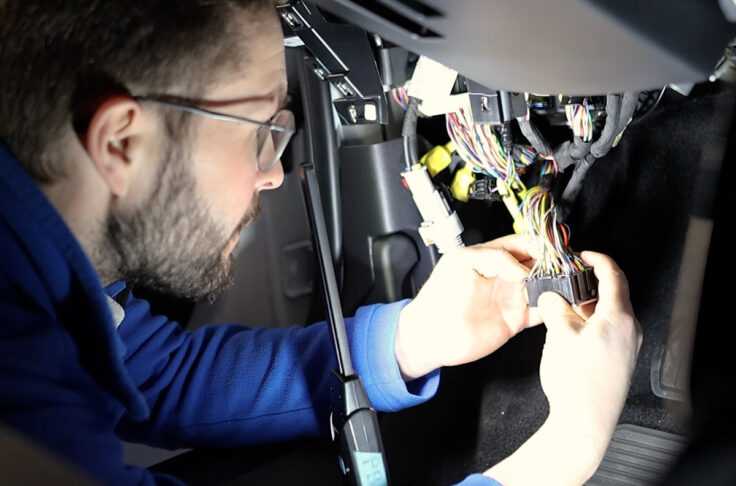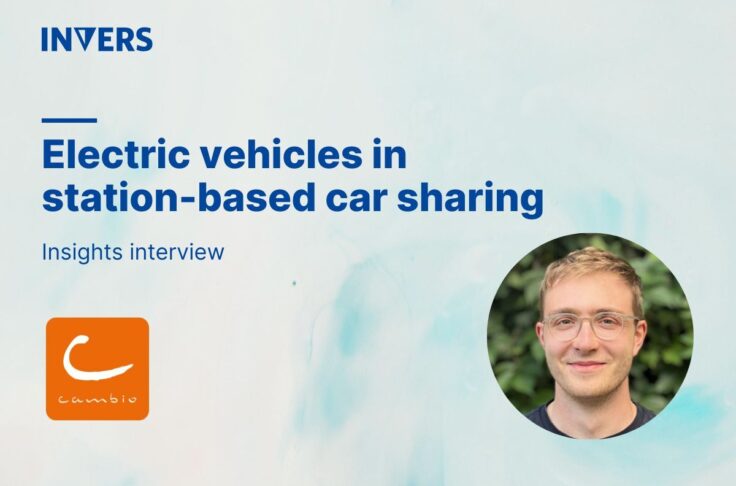What the 3G Shutdown Means for Your Car Sharing Fleet

The global phase-out of 3G networks is underway, making room for advanced technologies like 4G, LTE-M, and 5G. This transition is inevitable, and staying ahead is crucial to prevent sudden fleet disconnections. While adapting to new technology can be challenging, we’re here to guide you through the process.
In this article, we’ll explore the impact of the 3G shutdown on car sharing, the transition from 3G to LTE-M, and how INVERS can support you every step of the way.
Table of Contents
Understanding Connectivity Generations
2G, 3G, 4G, and 5G networks represent different generations of connectivity, each with unique capabilities and limitations:
2G (Second Generation)
2G technology introduced digital voice calls and SMS text messaging, along with basic data services like GPRS and EDGE. While it laid the groundwork for telematics solutions, its power efficiency comes at the cost of slower data speeds.
3G (Third Generation)
3G brought faster internet speeds, better web browsing, and app usage through technologies like UMTS and HSPA. It enabled real-time tracking and basic telematics for carsharing operations. However, 3G still faces higher latency and limited advanced features compared to newer generations.
4G (Fourth Generation)
4G technology offers high-speed internet and supports complex applications. For carsharing, it enables advanced telematics functions such as real-time diagnostics and in-car infotainment. While 4G is a significant improvement, it still experiences some latency and coverage issues in remote areas.
5G (Fifth Generation)
5G provides ultra-high-speed, low-latency connectivity suitable for data-heavy applications like virtual reality and autonomous vehicles. In carsharing, 5G can support advanced applications such as real-time vehicle-to-vehicle (V2V) and vehicle-to-infrastructure (V2I) communications. However, 5G currently faces limited infrastructure and higher deployment costs.
LTE-M (Long-Term Evolution for Machines)
LTE-M is designed specifically for IoT applications, offering excellent signal strength, penetration, and reliability. It’s ideal for carsharing due to its stable and efficient communication between vehicles and central systems. While it has lower data rates compared to 5G, LTE-M is more than sufficient for telematics applications.
NB-IoT (Narrowband Internet of Things)
NB-IoT is another technology worth mentioning. It provides even better penetration than LTE-M, making it suitable for IoT devices in challenging environments. However, NB-IoT does not support mobility, which limits its application in carsharing scenarios where vehicles are constantly on the move.
Sunsetting 3G: when and where?
Many countries have already completed or initiated the 3G network phase-out. This transition allows for faster speeds, reduced latency, and increased capacity to meet current and future communication demands.
Completed 3G network shutdowns
- Asia-Pacific: Taiwan, Singapore
- Americas: United States of America
- Europe: Italy, Germany, Norway, Netherlands, Switzerland
Ongoing 3G shutdowns
1. Asia-Pacific:
- Japan: Japanese carriers like NTT Docomo, KDDI, and SoftBank plan to shut down their 3G networks by 2026
- South Korea: Telecom companies like SK Telecom and KT have begun phasing out their 3G services
- China: Phasing out 3G to make way for 4G and 5G, supporting shared mobility services
- Australia: Telstra shut down its 3G network in mid- 2024, with other carriers following suit
2. Americas:
- Mexico: Plans to shut down 3G networks by 2024
- Brazil: Working to phase out 3G to facilitate the rollout of 5G
3. Europe:
- Belgium: Gradually phasing out 3G
- Spain: Gradually phasing out 3G, expected to complete by 2025
- Portugal: Moving towards phasing out 3G, with plans to complete by 2025
- Austria: Plans to shut down 3G by the end of 2024
- UK: Expected to maintain 3G services until the late 2020s but shifting towards 4G and 5G
Planned 3G Shutdowns
1. Asia-Pacific:
- Hong Kong: Has yet to announce a specific sunset date for its 3G network, but it is transitioning towards 4G and 5G
- Thailand: Transitioning away from 3G, with major providers focusing on expanding 4G and 5G coverage
- India: In the process of phasing out 3G, with a solid shift to 4G and 5G
- New Zealand: Mobile operators plan to shut down 3G by the end of 2025
2. Americas:
- Canada: Bell, Rogers, and Telus plan to shut down 3G by the end of 2025
Why is 3G being shut down before 2G?
The shutdown of 3G networks is a complex process that differs by country. While some regions are phasing out 3G before 2G, others are taking different approaches.
In many cases, telecommunications carriers are maintaining 2G networks for IoT applications due to:
- Spectrum and power efficiency
- Widespread global coverage, especially in rural areas
- Cost-effectiveness for large-scale IoT deployments
- Regulatory requirements in some regions
However, the reasons for shutting down 3G networks often include:
- Repurposing spectrum for more advanced 4G and 5G services
- Improving overall network efficiency
- Reducing maintenance costs for older infrastructure
By phasing out older networks, carriers can focus on newer technologies while still maintaining basic connectivity for IoT devices through remaining 2G networks (where applicable) and newer low-power wide-area network (LPWAN) technologies like LTE-M. This approach enables a smoother transition to advanced technologies while ensuring essential IoT services remain available.
Consequences of delaying the switch
Just because your country still supports 3G technology doesn’t mean you should sit and wait it out. Delaying the switch from 3G to newer networks can lead to significant operational and financial challenges:
1. Data delays, fleet tracking disruptions, and operational inefficiencies
Slow data transmission and increased latency can disrupt real-time location updates, vehicle tracking, booking systems, billing processes, customer service response times, and overall operational efficiency.
2. Non-compliance with regulatory mandates
Many regions require modern communication technologies for safety and operational efficiency. Failing to upgrade may lead to penalties and legal issues.
3. Increased maintenance costs
Maintaining outdated 3G devices will become more expensive as telecom providers phase out support, leading to higher service charges and difficulty finding replacement parts.
4. Loss of Competitive Edge
Competitors using newer technologies will offer better service quality, attracting more customers and increasing market share. Falling behind in technological upgrades can lead to a significant loss in business opportunities and revenue.
5. Forced rapid transition
Transitioning while 3G is still available allows for a gradual upgrade. Delaying may force a sudden, rushed transition, leading to operational disruptions and increased costs.

The INVERS solution for fleet managers
INVERS offers a comprehensive telematics solution built to ensure seamless connectivity and operational efficiency.
What is the INVERS Solution?
The INVERS CloudBoxx is a high-performance telematics device designed for car-sharing operations. CloudBoxx utilizes LTE-M for high-speed, resilient machine-to-machine connectivity. LTE-M excels in maintaining connections in challenging environments such as underground parking and dense urban areas. It is standardized internationally and available in over 50 countries, making it ideal for multi-region operations. Additionally, CloudBoxx supports 2G as a fallback option.
How it works
Managed Connectivity uses highly available, fail-over secured VPN connections distributed across multiple regions for consistent global service. CloudBoxx features dual SIM technology, eliminating the need for user-provided SIM cards. Each SIM can connect to hundreds of networks worldwide, ensuring optimal connections by automatically switching to the best available network. eSIMs can be remotely managed, reducing the time and effort required to activate and manage large fleets of vehicles.
Managing Telematics Data During the Transition from 3G to LTE-M
A common concern is compatibility. The INVERS CloudBoxx is vehicle-agnostic and features streamlined installation and configuration procedures, allowing you to easily in-fleet any vehicle.
Transition timeline
The typical transition and onboarding process to the INVERS CloudBoxx takes a structured approach to minimize disruption. The transition can be completed in a matter of weeks, depending on the size of your fleet and specific requirements. INVERS provides a detailed transition plan and extensive support throughout the process, including technical assistance and training programs.
Contingency Plans
INVERS has robust contingency plans to address unexpected delays in the 3G shutdown or issues with 4G/LTE/5G networks. INVERS’ managed connectivity service ensures that your fleet can switch to alternative networks if there are issues with the primary network.
For instance, in February 2024, several undersea cables in the Red Sea were damaged, disrupting internet connectivity between Europe and Asia. INVERS’ support team monitored and managed connectivity for car-sharing operators in Asia. They identified a routing problem outside the INVERS system and proactively set up additional network communications to keep car-sharing operators in the Southeast Asian region online.
Future-proof your operation
As cellular networks evolve from 3G to 4G and beyond, INVERS CloudBoxx stays ahead of the curve. Its multi-band capability seamlessly adapts to emerging technologies, ensuring your fleet remains connected even as networks change. With LTE-M as its primary technology and 2G as a reliable fallback, CloudBoxx offers uninterrupted connectivity across 50+ countries, keeping your car-sharing operations running smoothly now and in the future.
Talk to us today to learn how we can support your transition and help your business thrive in the evolving telematics landscape.


